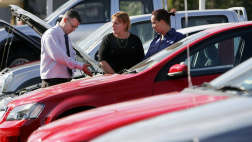Fuel savings in some European cars are 10 per cent better than similar cars sold in Australia. The problem is Australia's high sulfur content in petrol that damages the new emission-reduction technology.
This technology also reduces fuel consumption. Mercedes-Benz engine development director Roland Kemmler says one of his company's 3.5-litre V6 petrol engine averages 6.8 litres/100km - compared with about 9 l/100k m for a four-cylinder Toyota Camry - but the engine couldn't operate on high-sulfur petrol available in Australia.
"By comparison, the 3.5-litre V6 engine without the new technology gets about 7.5 l/100km,'' he says. "So the saving of 10 per cent is not available in countries without the cleaner petrol.
There is no difference in the power and performance of the two engines - just the emissions and fuel economy.'' The low-emission engine uses a stratified - or lean-burn - process that puts less petrol into the engine.
"Over the old SL350, the total savings are actually more than the 10 per cent in fuel use because the new car is lighter, more aerodynamic and has a stop-start system,'' Mr Kemmler says.
"Compared with the old SL350, the new one uses 30 per cent less fuel.'' The new 3.5-litre V6 is available in Mercedes-Benz models in Europe such as the SL convertible (released this week), C-Class sedan and E-Class models. Mr Kemmler says the engine technology was "being considered'' for the V8 engine range and also for the four-cylinder models.
Mercedes-Benz Australia spokesman Jerry Stamoulis says his company isn't in a position to introduce more efficient engines for its cars until Australia adopted low-sulfur fuel standards.
Australia reduced its sulfur content in petrol to 50 parts per million (ppm) about six years ago. Previously it was 500ppm. Europe has fuel that has less than 10ppm. Sulfur erodes the car's catalytic converter that is the key component in reducing toxic exhaust emissions.





.jpg)
.jpg)
.jpg)

_0.jpg)



.jpg)
 (1).jpg)


.jpg)


.jpg)
.jpg)

.jpg)
.jpg)




